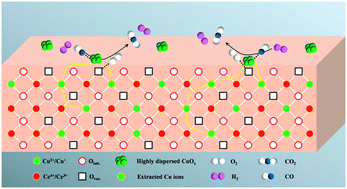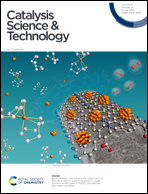Investigation of the re-dispersion of matrix Cu species in CuxCe1−xO2 nanorod catalysts and its effect on the catalytic performance in CO-PROX†
Abstract
In the present work, CuxCe1−xO2 nanorod catalysts synthesized by a co-precipitation method were treated with nitric acid to remove all the surface copper species and merely preserve the matrix copper species in the framework of ceria. With the subsequent thermal treatment at various temperature, the re-dispersion phenomenon of the matrix copper was investigated to different degrees and showed a profound influence on the catalytic performance in CO-PROX. Various analysis methods (XRD Rietveld refinement, HRTEM, XPS, H2-TPR and in situ DRIFTs) were used to characterize the texture/structure property, redox property and surface element distribution of the catalyst along with the re-dispersion process. The acid-treated process not only diminished the active copper species for CO adsorption but also destroyed the surface oxygen vacancy, which severely damaged the low-temperature CO oxidation activity of H–CuCe(rod). Motivated by the thermal treatment, the matrix copper species shifts from the framework to the surface region, and is dispersed as surface CuOx species. In cooperation with the recovered oxygen vacancy, the interfacial interaction between copper and ceria was rebuilt and the catalytic performance of H–CuCe(rod) was remarkably enhanced with higher CO conversion (T50%: 137 °C to 80 °C) and a broader temperature window (width: zero to 50 °C). With further elevating the calcination temperature, much more matrix copper species was re-dispersed as surface CuOx species and further stimulated the low-temperature CO oxidation activity of H–CuCe(rod)-600. However, the deficiency of the matrix copper interacting with the ceria lattice and the reduced oxygen vacancy concentration led to a rapid decrease in CO conversion at high temperature and narrowed the temperature window for H–CuCe(rod)-600 in the preferential oxidation of CO (CO-PROX). Our findings reveal that the CO-PROX performance of a shape-controlled copper–ceria catalyst is highly sensitive to the distribution of copper species and could be regulated by the acid and subsequent thermal treatment process, providing a new insight into the development of highly efficient copper–ceria catalysts for CO-PROX.



 Please wait while we load your content...
Please wait while we load your content...